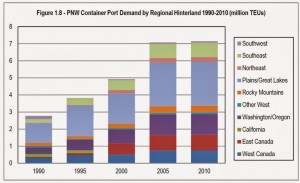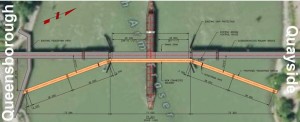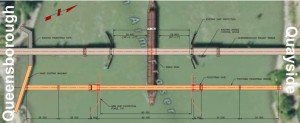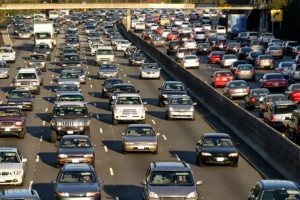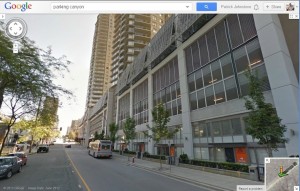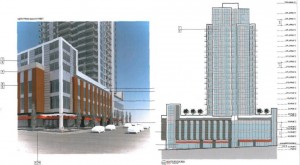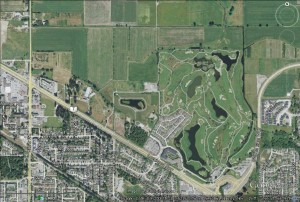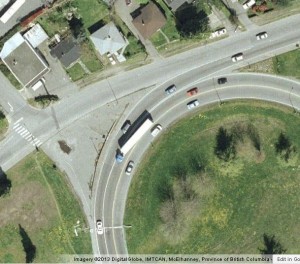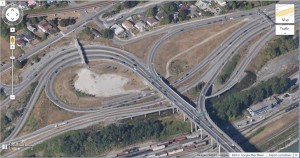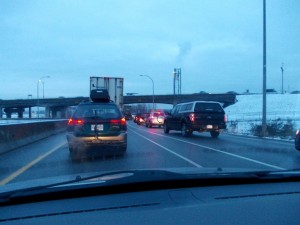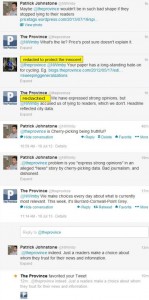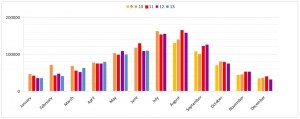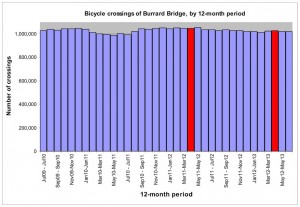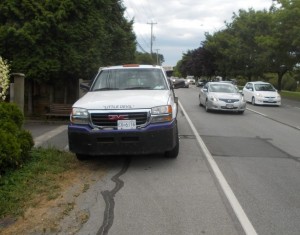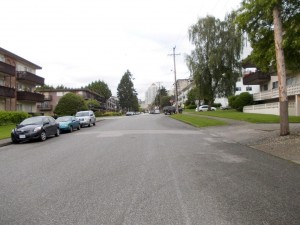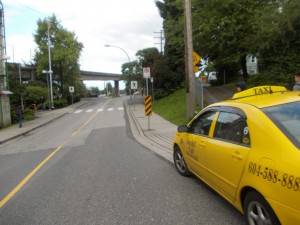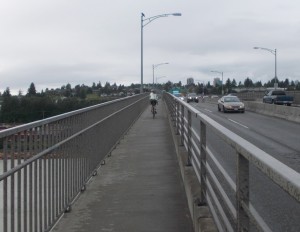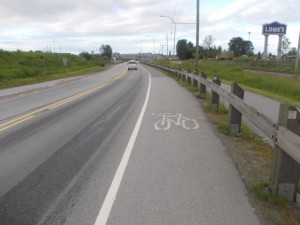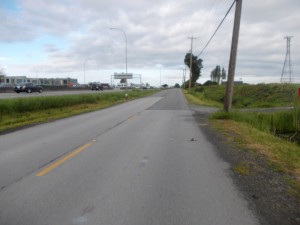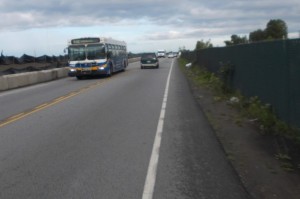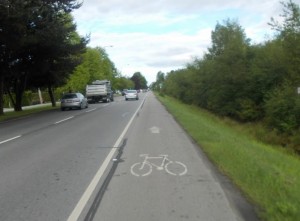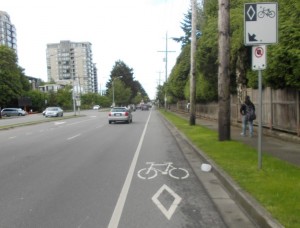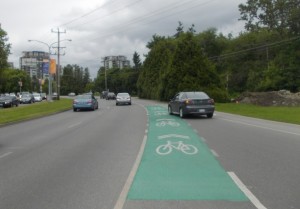You have to be a real transportation/Port/Environment geek to know that this is going on, but I thought it might be interesting to call attention to one of Port Metro Vancouver’s current projects. The Port plans to expand DeltaPort- the big island created out next to the Tsawwassen Ferry terminal – to double the capacity for the movement of containers.
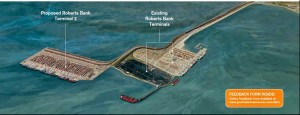 |
| PMV graphic, click to zoom in. |
They have just applied for an environmental assessment for the so-called Roberts Bank T2 Project, but are doing their own outreach to ask the community a few questions about the current project.
By “community”, I mean people South of the Fraser, because the pubic open houses are all being held south of the middle arm, but there is lots of opportunity for on-line comments, and with a comprehensive EA very likely, there should be more opportunity to talk over the next year or so.
My initial impressions are surprisingly (for some) not all that negative. However, before I present them, I need to do one of my every-so-often caveat things:
Although the footprint of this project is well outside of the City than employs me, my employer has been identified as a potential stakeholder in the project. I am in the department of the City that would theoretically be providing technical assistance to the City’s correspondence on the matter. That said, I have no pony in this race, nor have I any decision-making power in how EA or the Port plans advance, or how my employer approaches the EA. I am not privy to any behind-the scenes information, all I know about the project comes from the publicly-available records. Everything I say here is my opinion, not that of my employer or anyone else who may work for my employer, or any rational person, for that matter.
With that out of the way, I’ll give a quick description of the project. PMV wants to expand the container facility at DeltaPort. This is part of on-going expansion plans out there on Roberts Bank. To put the expansion in perspective, cast you mind way back to 2009, when Hannah Montana was still a thing, and the Roberts Bank Container facility had an annual capacity of 1.2 Million TEU per year (“TEU” is twenty-foot equivalent units, essentially a 20-foot long standard container. The ones you typically see on the back of trucks on Royal Ave are 40-foots, equivalent to 2 TEUs, although the 2.6 TEU 53-footers at are increasingly common).
In 2010 a third berth was opened, which boosted capacity 50%, to 1.8 Million TEU. Since then, an ongoing project to improve the rail and road connections and off-ship container handling is aiming to boost capacity by 2015 to 2.4 Million TEU. If approved and completed, the current project will boost capacity yet again, to 4.8 Million TEU. As full build-out of this project will not arrive until about 2024, the net result would be a quadrupling of container capacity over 14 years.
 |
| PMV’s own graphics Click to make bigger |
Clearly, the Port is bullish on containers.
There is much to be discussed here, as the projected growth will impact every bit of our City and region. I want to concentrate on two specific issues at this early stage, both close to my heart. Transportation and the Agricultural Land Reserve.
Transportation
If you think there are too many container trucks on Royal Avenue now, what will it be like when container throughput is increased three-fold? Where are all these containers going to go?
I dug through this recent report commissioned by the Port, and used as the justification for expanded container capacity at Roberts Bank, and the existing terminals in Burrard Inlet. There are a few lessons in here.
First off, Surrey Fraser Docks will not be a significant mover of containers at the Port for the foreseeable future, regardless of the fate of the tunnel or dredging of the river. Simply put, the average every-day container ships being built today are too large to navigate within the Fraser River. At 400m long and 60m wide, their 15m draught is the least of their worries. Port facilities along the Fraser River may have many uses, but moving containers on and off of boats will not be one of them, unless the Port decides to finally start investing in the type of short-sea shipping that was recommended to them a decade ago by this other report.
Second, note from the graph above (page 36 of the aforementioned report) that the vast majority of the import containers, more than 90% from 1990 to 2010, are bound for destinations outside of Western Canada. The forecasts deeper in the report suggest this trend will continue, as most growth calculations are based on competitive advantages accessing the Mid-West and eastern parts of North America though rail. This should reinforce the question – why are we moving these things around by truck? What are the economics of moving these containers from the boat to the truck to the multi-modal yard where they eventually end up on trains?
Part of the answer might be train capacity. It has been suggested by people much smarter than me that the single most pressing goods movement choke point in the Province is the New Westminster Rail Bridge, underlying a challenged rail infrastructure throughout the region.
However, this report suggests quite the opposite- saying that there is lots of rail capacity, and that the economic advantages of direct-to-rail are clear:
“… the costs associated with trucking containers from terminals to rail yards were obviously highly uncompetitive. Hence, there was a switch in favour of on-dock rail facilities, and all new container terminals on the west coast either incorporate such a facility or provide on-dock access to an adjacent rail yard.” –pg 146.
So the economics make sense, the global trend is established, and the Port is making plans to take advantage of this reality. Which makes me wonder why we are still investing heavily in the building of truck-freeways to move trucks from the Docks to the Intermodal Yards? Why are we being told we have to accept the community impacts and cost to the public purse of all these container trucks when the economics don’t make sense?
There was one shocking statement a few pages later under Conclusions:
“The only possible difficulty if proposed oil exports from Alberta were to compete for rail space with coal and container trains. Clearly, the correct mode for these exports will be by pipeline. This is the only potential capacity constraint for increased container volumes via Vancouver.” -pg 150
I don’t think any of us were under any illusions about the Port being an interested partner in the building of pipelines to move bitumen from Alberta to the west coast, but this dynamic is one that shows how complex, yet strangely tenuous, our transportation network truly is. How Coal snuck into the discussion here is another point of speculation. Are plans for expanded coal movement really suited to the Port’s expansion plans for containers?
Agriculture / Land Use
The current Port Boss has been questioning the preservation of Agricultural lands. He has gone so far as to say we don’t need farmland in BC, as we can import all of our food through his port. So it is really hard to give him the benefit for the doubt about this topic…but hear me out a bit.
It is possible that the building of new land out where DeltaPort is currently located will reduce the pressure to re-purpose existing new land in the lower Fraser Valley from farm to Port servicing. If we accept that the Port’s expansion models are realistic, and we accept that expanded movement of container goods is a great thing for our economy, and Roberts Bank Terminal 2 is designed to primarily move goods on and off of boats and on and off of trains (three big “ifs”, admittedly), then of all the places for this activity to take place, perhaps Roberts Bank is the best option. Maybe this is a project that Environmentalists can somehow “get to yes” on (to borrow the parlance of the day).
The habitat loss out on Roberts bank will be small, and adjacent to already highly disturbed habitat. With some creative design, there is no reason T2 would create any harm outside of its 100 hectare footprint. It could be argued that compensatory habitat required under the Fisheries Act will be of higher quality than that lost through this project, but that is yet to be seen, and something that will come out during the EA.
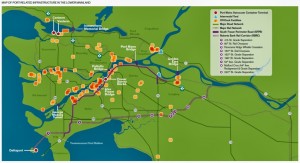 |
| PMV Graphics, Click to zoom in. |
Public meetings:
There will be 5 public meetings, starting tomorrow, led by the Port, and discussing three aspects of the project: Habitat Mitigation Plans, Methods for improving Port-related truck traffic; and ideas for community legacy benefits. As I said, they are all South of the Fraser, but you might want to make the trip and check them out:
October 16 @5:00pm-8:00pm UBC Boathouse, Richmond
October 17 @5:00pm-8:00pm Surrey Arts Centre, Surrey
October 22 @5:00pm-8:00pm Coast Hotel , Langley
October 24 @5:00pm-8:00pm Delta Town & Country Inn, Delta
October 26 @10:00am-1:00pm Coast Tsawwassen Inn, Delta
